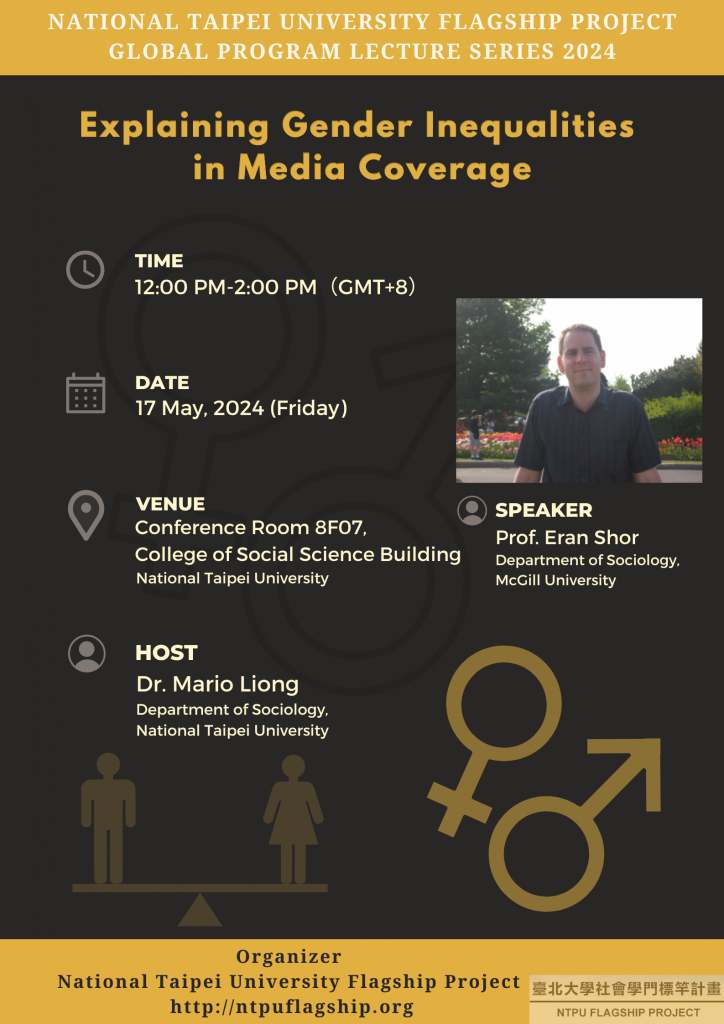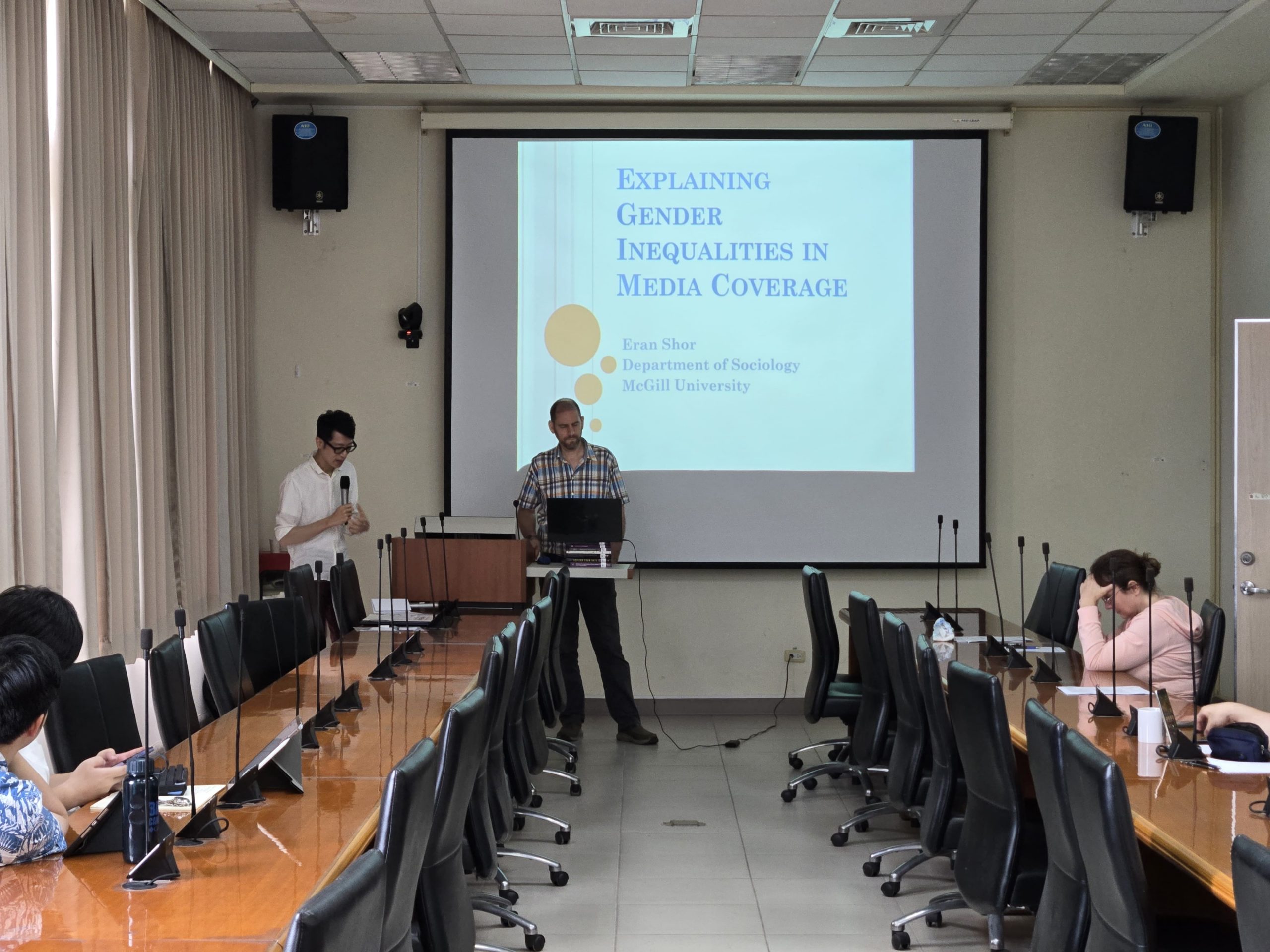演講紀錄
【開場】
Eran Shor教授先簡單介紹過去幾年他所進行的其他研究。像是透過跨國分析反恐及生化武器運用的政策短時間內在歐洲各國迅速立法的原因,探討政策與空間傳播之作用;在移民議題上則與健康做結合,針對移民死亡率悖論進行探討。Shor教授發現移民族群到新國家的壽命比當地人民更長,而在全球比較下,從發展中國家移民到已開發國家的壽命會較長。
【媒體的報導選擇】
Shor教授認為這除了受到媒體本身的立場、偏見影響外,其次,在於「公開權」的重要性。Shor教授指出對政治家而言,公開露面將有助於他們轉化成選舉時的募款及選票,對運動員、演員、商人則能夠透過公開宣傳產生更大的銷售商機;同樣地,像近期烏俄戰爭、加薩走廊等人道危機之報導,對後續跨國援助、政治鬥爭等面向的影響相當巨大。因此Shor教授認為這些人道危機獲得同等的關注度是更為重要的。
【性別在媒體出現的歷史趨勢】
20世紀時的研究表明,透過報紙姓名的英文對比,女性在報紙版面的報導量相當稀少。根據Global Media Monitoring Project(GMMP)的資料統計,報紙、電視、Facebook、Twitter 和 Instagram等媒介,女性和男性在新聞出現的比例為1:4,縱使近期女性進入公共領域的比例上升,但她們在媒體的出現次數並未成比例增加。此現象也讓Shor教授進一步探討新聞業整體性別差異的原因為何。首先,女記者的數量並不多,這也間接影響後續新聞種類的報導,女記者會是娛樂時尚、教育、社會福利等議題,而男記者則會是政治、商業、體育等新聞。加上媒體在新聞報導上因為自身利益的考量而選擇更容易吸引民眾的內容,而偏向主要為男記者所報導的議題(hard issue)。
另外,Shor教授點出大部分媒體的關注度,往往會將注意力集中在少數公眾人物(政商人士、名人等)的報導,這樣懸殊的比例,背後其實也隱藏性別不平等的現象。雖然在美國勞動力市場裡的男女比例相近,但職場裡的玻璃天花板,讓女性族群鮮少任職高階或領導性質之職位。他以G20峰會的出席領袖為例,女性比例相當稀少,加上性別偏見的影響,即使女性取得一定成就,所受到的關注可能仍比男性少。
–
另一個現象則是媒體對於公眾人物的形塑,或多或少仍受到「性別」的影響。媒體偏向針對女性公眾人物的負面經歷或困境來大書特書,對男性就相對友善。以川普和希拉蕊兩位政治人物為例,即使川普受到法律問題和性侵犯指控的影響,媒體仍舊持續圍繞他進行相關報導,而非在政治上更有資歷、經驗的希拉蕊。
【總結】
Shor教授最後總結媒體報導所呈現的性別不平等,受到相當多因素影響,包含前面所提到的性別偏見、性別地位信念,倘若女性打破隱藏在媒體中的玻璃天花板,這可能會讓她們在媒體報導上有負面效果。後續Shor教授也提到未來可以透過種族的角度切入探討,不過比起性別,在討論上會更為複雜且困難。
講者Speaker:Prof. Eran Shor(McGill University)
主持Host:Dr. Mario Liong(National Taipei University)
日期Date:2024/5/17(Fri)
時間Time:12:00 PM-2:00 PM(GMT+8)
地點Venue:Conference Room 8F07, College of Social Science Building
(國立臺北大學三峽校區社會科學院8F07會議室)
* The talk is conducted in English
Biography of Speaker:
My work spans several major research and teaching interests. First, I examine the causes and effects of political conflict and violence. More specifically, I study state counterterrorist policies, relying on a combination of longitudinal time-series cross-national analyses and case studies. My work demonstrates the importance of social and cultural processes in determining state policies and challenges more traditional theoretical approaches, which emphasize atomized actor-oriented and cost-benefit motivations.
Second, I am leading two separate research projects that examine inequality in the media coverage of ethnic minorities and women, using both qualitative content analysis and various statistical analysis methods. I critically explore the policing and silencing of political discourses by ethnic minority groups in Israeli media and the reaffirmation of national and collective boundaries through the exclusion of these ethnic minority groups. Third, I am conducting a large-scale statistical meta-analysis project, which explores the effect of different social stressors and of social relationships on mortality in different countries and under varying conditions. This project has already produced analyses of the effects of unemployment, war exposure, widowhood, divorce, lifetime non-marriage, participation in voluntary organizations, and social support, as well as a methodological paper on the use of meta-analysis in sociology. In addition, I plan to conduct analyses on the effects of social networks, immigration, and cumulative stressors on mortality.
Finally, pursuing my interests in gender and sexuality, I have completed a study on attraction between same-group members in Israeli kibbutzim. Relying on in-depth interviews with people who grew up in the communal education system of Israeli kibbutzim, I questioned the reigning psychological and biological views and offered alternative sociological explanations to the classic debate over the origins of incest avoidance and the incest taboo. I plan to extend this research by studying sexual attraction and avoidance in other small groups.
–
Abstract: Women receive substantially less media coverage than men. However, the reasons for these disparities are not always clear. While some theories point to societal-level structural and occupational gender inequalities, others suggest explanations that focus on the role of news reporters or editors and on news sources catering to public demand. In this talk I discuss more than a decade of research, utilizing computational analyses of millions of male and female names in more than 2,000 news sources. My analyses provide insights on the relative strength of these different explanations in accounting for persistent gender inequalities in the media.







